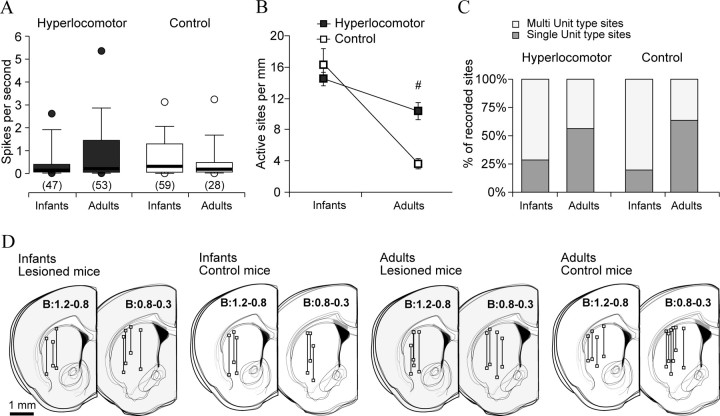Figure 3.
The normal ontogenetic decrease of spontaneous striatal activity occurring after infancy is regulated by dopamine pathways. Recordings of striatal neuron discharges and the frontal cortex LFP were performed in dopamine-depleted and control mice, during infancy (PD28–PD32) or adulthood (12–16 weeks after birth), with glass microelectrodes under urethane anesthesia. The locomotor activity of these animals is shown in Figure 1B. A, The average discharge rate of striatal neurons was assessed from 3-min-long signal segments, under slow-wave cortical activity. Data are the median (thick line), 25–75% (box), 10–90% (whiskers), and 5–95% (circles) of the distribution. The number of neurons in each group is given between parentheses. Discharge rates did not differ across treatments or along development (Kruskal–Wallis ANOVA). B, The density of spontaneously active striatal sites per mm of recording track decreased with age regardless of treatment (data are mean ± SEM; two-way ANOVA main effect of age, F(1,27) = 68.1, p < 7.3 × 10−9), but it decreased more steeply in controls than in lesioned mice (interaction between treatment and age, F(1,27) = 17.9, p = 0.0002; #Tukey post hoc test within adulthood, p < 0.0005). C, Further proof that striatal activity decreased with age was that the proportion of single-unit type sites (dark gray bars) increased between infancy and adulthood, in both controls (χ2 = 33.85, p < 0.00001) and dopamine-depleted mice (χ2 = 15.68, p < 0.0001). However, the proportion of single-unit sites did not differ between groups at either age (χ2 = 3.13, p = 0.07 within infancy; χ2 = 0.62, p = 0.4 within adulthood). D, Schematic drawings of coronal brain sections showing the localization of recording tracks and sites, in the four experimental groups [distance to bregma in millimeters, estimated according to the atlas of Franklin and Paxinos (2001)].

